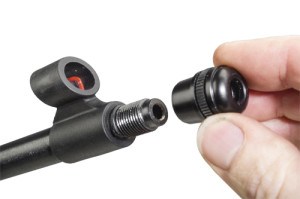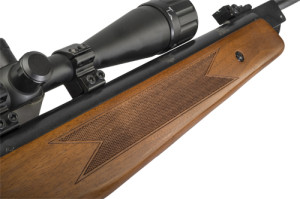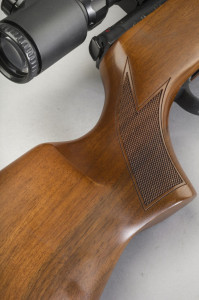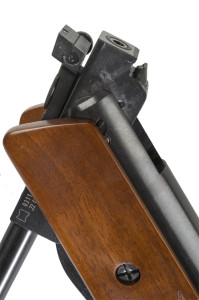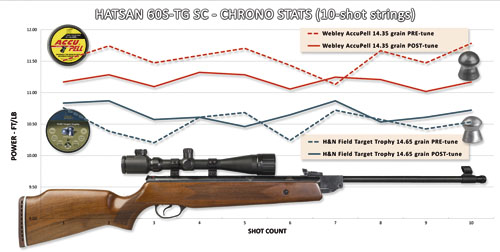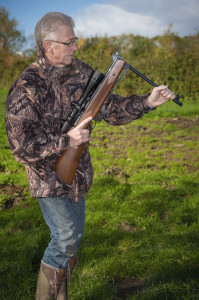Hatsan 60S-TG: it’s easy to see why this is a best-selling springer
Nigel Allen investigates
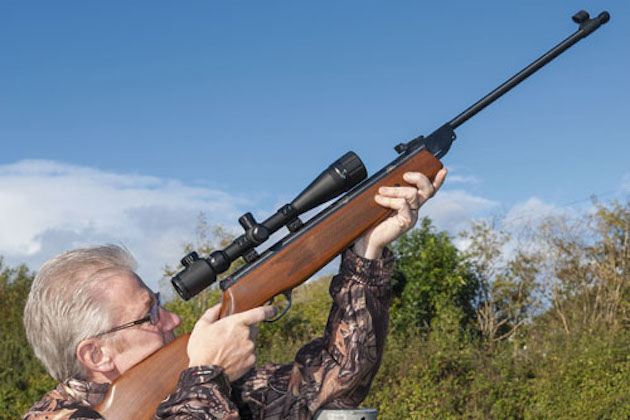
Airgun manufacturers in Turkey have really ramped up their game. Following their alliance with Webley, Hatsan has gone on to become a huge force in the UK marketplace.
The Hatsan 60S break-barrel springer is laden with features and offers up power in abundance. (Read our guide to the best air rifle pellets.)
The most common model is more correctly labelled the 60S-TG, as it comes with Tru-Glo open sights – but there’s also a 60S-TG SC which, for a few quid extra, features a screw-cut barrel, ready-threaded to 1/2in UNF for the easy fitting of a silencer.
Also available on FAC (around 18ft/lb) to special order, the 60S is a .22-only gun; if you’re a .177 fan, you need the model designated the 55S. Same rifle, smaller calibre.
Oh… and there’s a more expensive Vortex model of the 60 (formerly known as the 60S-G), which swaps the mainspring for a gas-ram.
Many of the airgun tune-up shops will attest to this Hatsan’s popularity by virtue of the fact they’re seeing more and more coming in for a performance polish-up.
SC variant of the Hatsan 60S-TG
I’ve had an SC variant of the 60S-TG for a while, initially testing it as an ‘off-the-shelf’ model, and trialling it following some work undertaken by ARC Tuning.
Spring-gun tuning
Tuning springers was a huge business between the late 1970s and 1980s, but the arrival of modern PCPs rather killed things off. I’m glad to say that spring-gun tuning is enjoying something of a revival, though – I think for two reasons.
Firstly, rifles emanating from the likes of Turkey and China have improved immensely in terms of quality and performance. And secondly, such guns are so inexpensive that owners can afford to splash out on having them tweaked up.
That’s not to say that these guns are sub-standard out of the box, but like anything that’s mass produced, having it ‘fiched’ to improve tolerances and smoothen out the running of all moving parts is bound to pay dividends – especially when the chassis has inherent potential.
In the case of my Hatsan 60S, I opted for ARC Tuning’s ‘standard’ tune-up – which bought me a new mainspring, guide, top hat and internal polish and relube.
In total, it took the cost of the new rifle to around £230. Considering my gun’s overall performance now, I’d call it an outstanding bargain.
But first, let me track back to the rifle’s arrival with me, ex-factory.
Like much hardware of Turkish origin, it’s a big gun. Surprisingly narrow, its girth combines with the 450mm-long barrel to really accentuate the rifle’s length, although the pull length of just 352mm does help to keep things manageable in your shoulder.
The stock’s walnut – Turkish, of course – and though my rifle’s grain isn’t anything to write home about, I’ve seen a few examples that have extremely impressive figuring. (Read more on Turkish walnut and guns here.)
It’s well sealed and sports laser-cut chequer panels on the grip and forend.
Do I hold a rifle differently from everyone else or something? I always think the forestock panel, while looking ‘balanced’, is always placed too far back; I grip my stocks much nearer the front than the stockmakers think.
Although it lacks the finish one might expect from a luxury wood option, the stock is perfectly practical, offering a raised comb for right- and left-handed use.
There’s some semblance of a thumb muscle cutaway on the right of the grip, though not the left – but for all intents and purposes, you can shoot from either shoulder without compromise.
A black-and-white-line spacer and ventilated rubber butt pad completes a fairly basic, but functional stock that I can’t help thinking would be equally as good in a cheaper hardwood.
The metalwork is evenly blued, but lacks that final pre-blue polish that would really lift things to a deluxe status.
Considering the quality of finish you get on Turkish shotguns, it bemuses me a little – but at the price point of the Model 60, it’s more an observation than a criticism. You can’t have everything!
It’s all been really well engineered, however, with the all-important breech lock-up being very tight.
It uses a sprung plunger that engages behind a cross-pin running through the jaws, and the breech block pivots around a bolt that incorporates a locking grubscrew.
Even after a few thousand rounds, I can report that there’s no hint of play anywhere – and I’d place a fair old bet that the 60 could compete on a par with Hatsan’s fixed-barrel, underlever offerings in terms of accuracy.
Sights-wise, the TG suffix denotes Tru-Glo fibre-optics, which are incorporated into synthetic, moulded fore- and rearsight units.
The foresight sits behind the capped and threaded muzzle on the SC variant. The rear is fully adjustable in both planes by click-stop thumbwheels, the elevation turnscrew being numbered for ease of reference.
I must make special mention of the foresight. Fibre-optics need plenty of light to work properly, otherwise, what’s their point? Thus, many manufacturers refrain from protecting them with a hood, which leaves them a little vulnerable to damage.
Hatsan, though, deploy a sturdy hood that’s been angled at the front to allow light to then fall onto the surface of an L-shaped rod located on the non-shooter side of the foresight blade.
This directs loads of light through to the red ‘dot’, making it highly visible to align between the green dots that flank the rearsight leaf. Clever stuff.
More clever ideas
There are two more clever ideas incorporated into this Hatsan, too. First, the trigger.
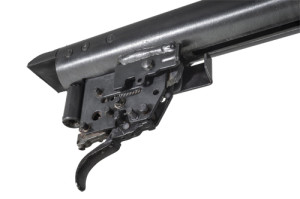
The two-stage Quattro trigger includes a drop-safety interlock – and knocks spot off the opposition in this price bracket
Known as the Quattro, this Hatsan-designed two-stager really is rather good – and knocks spots off the rest of the opposition in this price bracket.
It offers independent adjustments to alter the pull weight, first- and second-stage travel and main sear engagement and incorporates a drop-safety interlock – a device that stops the trigger sears letting go should the rifle be dropped, even after the safety catch has been disengaged.
That safety pops out of the end of the main receiver automatically on cocking, and can be re-engaged after it’s been pushed off.
The Hatsan 60S may also be decocked in the usual manner, if required, as there’s no anti-beartrap fitted. Personally, I like to have this tension-saving option on a sporting springer.
Another clever idea is Hatsan’s proprietary Shock Absorber System, which they dub SaS and emblazon by way of a gold etching on the receiver.
The company takes airgun ‘kick’ seriously, developing recoil absorption on a number of models in varying ways, like the Triopad butt system which incorporates a honeycomb buffer.
On the Model 60, SaS is incorporated as part of the union between action and forestock. Rather than the stock bolts screwing directly into the cylinder – or a bridge welded into place as on some models – the bolt housing sits on a piece of springy steel.
The idea is that any vibration on firing is ‘dampened’, thus improving the overall feel of the firing cycle and protecting the delicate internals of any scope that you may have mounted onto the rifle’s lengthy dovetails.
So… does it all work? Well, the trigger most certainly is in a league of its own. In the interests of a full test, I played around with the settings a lot, and was most impressed with its performance, not to mention its sensitivity of adjustment.
As to the SaS, I’m not convinced it makes a significant difference compared to a conventionally stock-mounted union.
Out of the box, the Hatsan 60S firing cycle was exactly what I expected from a mass-produced, full-powered springer. Recoil wasn’t ‘harsh’, but I’m sure I could have soothed things down a little with a dollop of grease applied to the mainspring.
Compared to many other springers in this price bracket, the Hatsan’s firing cycle didn’t seem any the tamer because of SaS – although all credit to the designers for looking at ways to improve shooter friendliness.
The rifle needed 100 shots or so to burn off the excess lubricants applied at the factory, after which velocities settled down, consistently delivering power levels in the region of 11 to 12ft/lb.
Not being choked, the barrel was a little pellet ‘fussy’ in that it took a while to find the right diet. Webley AccuPell and JSB-made rounds returned the most power, with H&N Sport’s Field Target Trophy proving the most accurate.
That said, I had to work hard to consistently achieve sub-35mm groups at 25 yards.
While all springers require a concerted effort on the part of the shooter, tuning them up does make life easier – and, sure enough, after ARC Tuning had waved their magic wand over my Model 60S’s action, the gun’s accuracy certainly improved by around five yards or so.
As you would expect from such work, the firing cycle was smoother. And, perhaps, this kind of tinkering does justice to Hatsan’s SaS system because, post-tune, I found it easier to follow-through the shot and called far fewer ‘flyers’.
Interestingly, the ARC-worked gun was slightly less powerful than before (although they can set it to any level you want).
Not that I minded; the cocking effort seemed a little easier with the ARC spring fitted – though in terms of cocking smoothness, the standard rifle was always pretty good in the first place.
Do I think the tune-up was worth it? Definitely – my Hatsan is purring like a tiger.
Do I think a tune-up is necessary for the Hatasn 60S? Not at all!
The 60S is a fine rifle straight out of the box and its trigger alone will help get you shooting right on the button.
But it’s also such a well-engineered rifle that, like those Weihrauchs, Feinwerkbaus and Originals back in the Seventies, it really does respond well to a few internal tweaks by the experts.
Tuning-up a Model 60 is simply money well spent on an air rifle that’s, erm… money well spent!
Nigel Allen
This review was originally published in Airgun Shooter in 2014 and has been updated. Prices are as originally reviewed.

